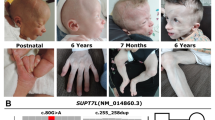Abstract
The Cbfa1 gene, which encodes the transcription factor Osf2/Cbfa1 required for osteoblast differentiation in mouse and human, is mutated in cleidocranial dysplasia, a skeletal dysplasia. We describe here the isolation of the full-length human OSF2/ CBFA1 cDNAs, the genomic organization of the entire CBFA1 gene, its expression, and the existence of an alternative splicing event. Nucleotide sequence analysis of the human and mouse OSF2/CBFA1 cDNAs showed a 98% homology in the coding sequence and 96% in the 5′ untranslated (UTR) sequence. Analysis of CBFA1 genomic clones revealed that the 5′ UTR sequence of the human OSF2/CBFA1 cDNA lies 75 kb upstream of the originally described 5′ end of the gene. The existence of two OSF2/CBFA1 cDNAs is due to an alternative splicing event around exon 8 that affects the transcriptional activity of the protein. Northern blot analysis demonstrates that the expression of the human OSF2/CBFA1 gene is restricted to osteoblastic cells.
Similar content being viewed by others
References
Ahn M-Y, Bae S-C, Maruyama M, Ito Y (1996) Comparison of the human genomic structure of the Runt domain-encoding PEBP2/CBFα gene family. Gene 168, 279–280
Bae S-C, Takahashi E-I, Zhang YW, Ogawa E, Shigesada K, Namba Y, Satake M, Ito Y (1995) Cloning, mapping and expression of PEBP2αC, a third gene encoding the mammalian runt domain. Gene 159, 245–248
Brown T (1993) Southern blotting onto a nylon membrane with an alkaline buffer. In Current Protocols in Molecular Biology, FM Ausubel, R Brent, RE Kingston, DD Moore, JG Seidman, JA Smith, K Struhl, eds. (Boston: John Wiley & Sons, Inc.), Vol. 1, p 2.9.7.
Chen C, Okayama H (1987) High-efficiency transformation of mammalian cells by plasmid DNA. Mol Cell Biol 7, 2745–2752
Chen Z, Harless ML, Wright DA, Kellems RE (1990) Identification and characterization of transcriptional arrest sites in exon 1 of the human adenosine deaminase gene. Mol Cell Biol 10, 4555–4564
Ducy P, Karsenty G (1995) Two distinct osteoblast-specific cis-acting elements control expression of a mouse osteocalcin gene. Mol Cell Biol 15, 1858–1869
Ducy P, Zhang R, Geoffroy V, Ridall AL, Karsenty G (1997) OSF2/Cbfa1: a transcriptional activator of osteoblast differentiation. Cell 89, 1–20
Geoffroy V, Ducy P, Karsenty G (1995) A PEBP2/AML-1-related factor increases osteocalcin promotor activity through its binding to an osteoblast-specific cis-acting element. J Biol Chem 270, 30973–30979
Komori T, Yagi H, Nomura S, Yamaguchi A, Sasaki K, Deguchi K, Smizu Y, Bronson RT, Gao YH, Inada M, Sato M, Okamoto T, Kitamura Y, Yoshiki Y, Kishimoto T (1997) Targeted disruption of CBFA1 results in a complete lack of bone formation owing to maturational arrest of osteoblasts. Cell 89, 755–764
Levanon D, Negreanu V, Bernstein Y, Bar-Am I, Avivi L, Groner Y (1994) AML1, AML2, and ALM3, the human members of the runt domain gene-family: cDNA structure, expression, and chromosomal localization. Genomics 23, 425–432.
Lee B, Thirunavakkarasu K, Zhou L, Pastore L, Baldini A, Hecht J, Geoffrey V, Ducy P, Karsenty G (1997) Misserne mutations abolishing DNA binding of the orteohlart-specific transcription factor osfz/chfaz, in cleido cranial dysplesia
Mundlos S, Mulliken JB, Abramsonm ML, Warman JH, Knoll, JHM, Olsen BR (1995) Genetic mapping of cleidocranial dysplasia and evidence of a microdeletion in one family. H.M.G. 4, 71–75
Mundlos S, Otto F, Mundlos C, Mulliken JB, Aylsworth AS, Albright S, Lindhout D, Cole WG, Henn W, Knoll JHM, et al. (1997) Mutations involving the transcription factor CBFA1 cause cleidocranial dysplasia. Cell 89, in press.
Ogawa E, Maruyama M, Kagoshima H, Inuzuka M, Lu J, Satake M, Shigesada K, Ito Y (1993) PEBP2/PEA2 represents a family of transcription factors homologous to the products of the drosophila runt gene and the human AML1 gene. Proc Natl Acad Sci USA 90, 6859–6863
Otto F, Thornell AP, Crompton T, Denzel A, Gilmour KC, Rosewell IR, Stamp GWH, Beddington RSP, Mundlos S, Olsen, BR, Selby PB, Owen MJ (1997) Cbfa1, a candidate gene for the Cleidocranial Dysplasia syndrome, is essential for osteoblast differentiation and bone development. Cell 89, in press.
Sambrook J, Fritsch EF, Maniatis T (1989) Molecular Cloning: A Laboratory Manual, C. Nolan, ed. (New York: Cold Spring Harbor Laboratory Press).
Sillence, DO, Ritchie HE, Selby PB (1987). Animal model: skeletal abnormalities in mice with cleidocranial dysplasia. Am J Med Genet 27, 75–85
Strauss WM (1994) Preparation of genomic DNA from mammalian tissue. In Current Protocols in Molecular Biology, FM Ausubel, R Brent, RE Kingston, DD Moore, JG Scidman, JA Smith, K Struhl, eds. Vol. 1, pp. 2.2.1–2.2.3, (Boston: John Wiley & Sons, Inc.), Rhodes scholar.
Wijmenga C, Speck NA, Dracopoli NC, Hofker MH, Liu P, Collins FS (1995) Identification of a new murine runt domain-containing gene, Cbfa3, and localization of the human homolog, CBFA3, to chromosome 1p35-pter. Genomics 26, 611–614
Author information
Authors and Affiliations
Rights and permissions
About this article
Cite this article
Geoffroy, V., Corral, D.A., Zhou, L. et al. Genomic organization, expression of the human CBFA1 gene, and evidence for an alternative splicing event affecting protein function. Mammalian Genome 9, 54–57 (1998). https://doi.org/10.1007/s003359900679
Received:
Accepted:
Issue Date:
DOI: https://doi.org/10.1007/s003359900679




